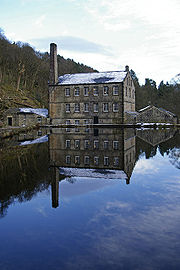
Hardcastle Crags
Encyclopedia

West Yorkshire
West Yorkshire is a metropolitan county within the Yorkshire and the Humber region of England with a population of 2.2 million. West Yorkshire came into existence as a metropolitan county in 1974 after the passage of the Local Government Act 1972....
, England
England
England is a country that is part of the United Kingdom. It shares land borders with Scotland to the north and Wales to the west; the Irish Sea is to the north west, the Celtic Sea to the south west, with the North Sea to the east and the English Channel to the south separating it from continental...
, owned by the National Trust
National Trust for Places of Historic Interest or Natural Beauty
The National Trust for Places of Historic Interest or Natural Beauty, usually known as the National Trust, is a conservation organisation in England, Wales and Northern Ireland...
. It lies approximately 2 miles (3.2 km) north of the town of Hebden Bridge
Hebden Bridge
Hebden Bridge is a market town within the Metropolitan Borough of Calderdale, in West Yorkshire, England. It forms part of the Upper Calder Valley and lies 8 miles west of Halifax and 14 miles north east of Rochdale, at the confluence of the River Calder and the River Hebden .A 2004 profile of...
.
Gibson Mill
Approximately half a mile along the valley there is a 19th-century cotton mill called Gibson Mill. The mill was water powered and has been renovated to demonstrate renewable energy sources and a sustainabilitySustainable development
Sustainable development is a pattern of resource use, that aims to meet human needs while preserving the environment so that these needs can be met not only in the present, but also for generations to come...
strategy. It is surrounded by 400 acres (1.6 km²) of unspoilt woodland and crossed by 30 miles (48.3 km) of footpaths. The former cotton mill was one of the first powered mills built at the start of the industrial revolution.
Water powered turbines, photo voltaic panels, composting toilets and locally sourced reclaimed interior materials have gone into making the venture sustainable.
The mill reopened on Saturday, 24 September 2005 and there are exhibits about the mill and its workers.

